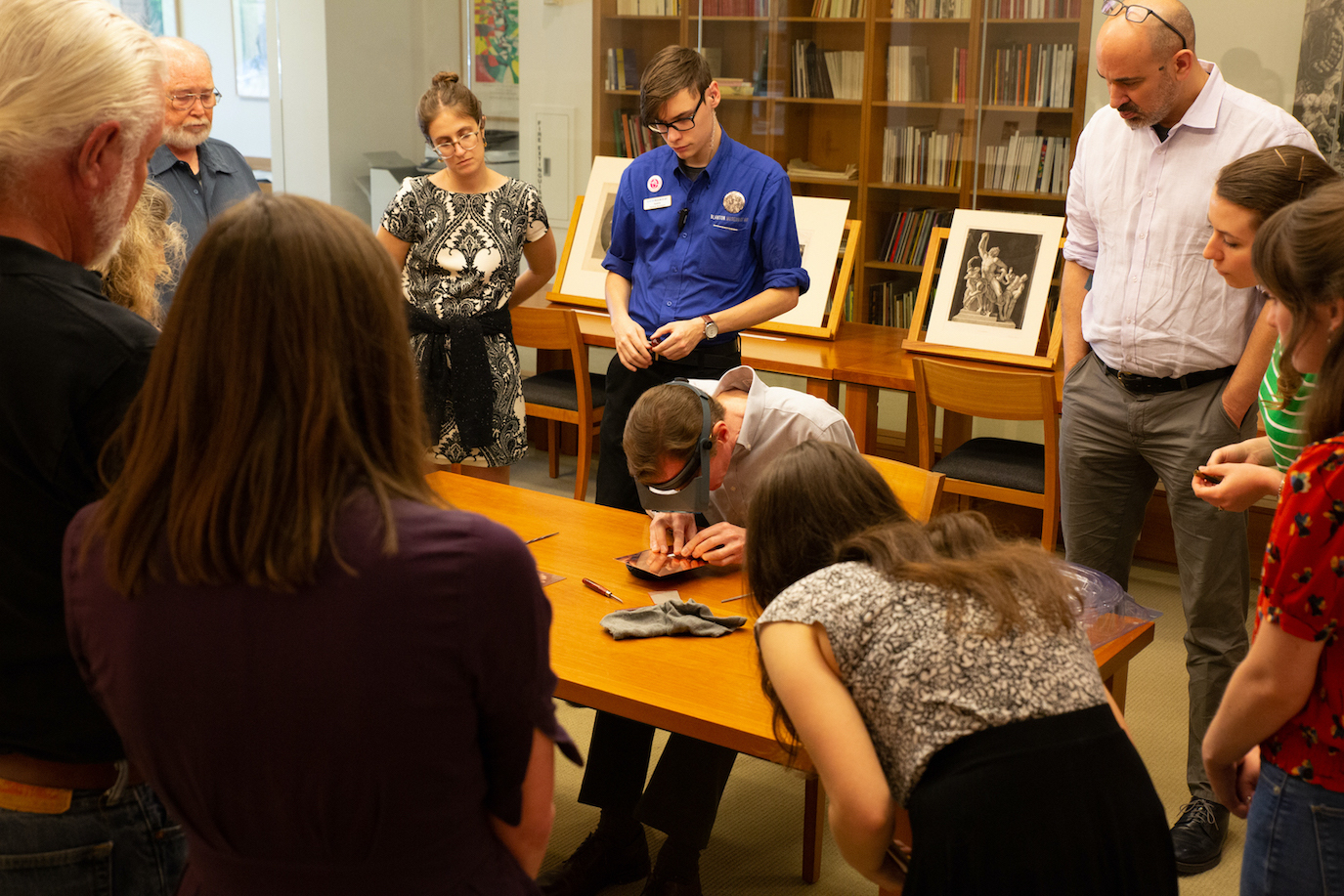
About
The H-E-B Study Room is open by appointment only. Contact the Prints & Drawings department at 512-471-9208 or email at prints@blantonmuseum.org with further questions about researching the prints and drawings collection.
Located within the Julia Matthews Wilkinson Center for Prints and Drawings, the H-E-B Study Room is a public study center designed to accommodate classes, individual scholars, collectors, connoisseurs, and museum visitors who wish to study and enjoy works of art owned by the Blanton Museum of Art. Named for Julia Matthews Wilkinson, who received a Bachelor of Fine Arts from UT in 1970, the department houses its collections, as well as curatorial offices, a preparator’s workspace, and a small reference library.
Collection
Prints and drawings comprise 90% of the Blanton’s collection of almost 18,000 works, making it the largest and most comprehensive collection of its kind in Texas and the Southwest. Benefactors have given some or all of their art collections and have supported important art acquisitions with works dating from the fourteenth century to the present. The department’s highlights include the Barbara Duncan Collection of Latin American drawings, the Suida-Manning Collection of Old Master drawings, and the Leo Steinberg Collection of prints. The department also showcases American prints from the first half of the twentieth century given to the Blanton by Julia (B.F.A. 1970) and Stephen Wilkinson (J.D. 1974) and their family’s Still Water Foundation.
Upcoming Print-Related Events
No Events
Description & Print-Making Techniques
Relief
Relief prints are often characterized by bold contrasts of dark and light. In this technique the artist first sketches a composition on a hard, flat surface such as a wood or linoleum block; then, the parts of the image that are not to receive ink (the negative space) are carved away from the surface, leaving the composition visible on the raised surface of the block. Ink can be applied to these raised printing areas by dabbing or with a roller. The inked surface of the block is then transferred to paper with a mechanical press or by laying a sheet of paper on the block and rubbing the paper. Since the areas of the block that were cut away did not receive ink, they appear white in the printed image. The inked areas are impressed into the surface of the paper from the force of the press and so appear slightly indented on the reverse side of the paper. The primary relief techniques are woodcut, wood engraving, rubber stamp, and linocut.
Intaglio
The term intaglio comes from the Italian word intagliare, meaning “to incise.” In this technique, acid or a pointed tool is used to incise into a metal plate, usually made of copper, but sometimes of steel, iron, or zinc. After the image has been drawn, the plate is covered with ink, and then wiped so that only the incised areas contain ink. The plate is then laid on a press, with dampened paper placed over it. Lambs-wool felt blankets are then placed over the paper, protecting it and the plate while allowing them to go through sufficient pressure to force the paper into the incised lines in the plate. This pressure forces the paper into the incisions where it picks up the ink, resulting in the raised character of the lines on the impression. Because often the sheet of paper is larger than the plate, an indentation of the plate edges, or platemark, appears around the edges of the image area. The different types of intaglio prints are distinguished by the technique used: etching, aquatint, and photogravure are made using acid to corrode the metal plate, while engraving, drypoint, and mezzotint are made using a sharp tool to incise, or scratch, the surface of the plate. Often several different intaglio techniques are used in the same print to achieve variations in contrast and tone.
Planographic
In planographic printing, the printed and non-printed areas on the surface of the print exist in the same plane on the matrix. Lithography is a type of planography that relies on the antipathy between grease and water. The semi-absorbent surface of the stone or plate is treated so that parts of it are receptive to grease while others are receptive to water. In this method of printing the ink is neither pressed down into the stone nor raised above its surface, but lies exclusively on the plane of the stone’s surface. Planographic techniques include: lithography, zincography, and photolithography. Other planographic methods include serigraphy (screen printing), monotype, counterproof, collotype, and digital prints.
Sources
Gascoigne, Bamber. How to Identify Prints: A complete guide to manual and mechanical processes from woodcut to inkjet. New York: Thames & Hudson Inc., 2004.
Collecting Prints Basics. International Fine Print Dealers Association, 2009-2012. 12 February 2014.

